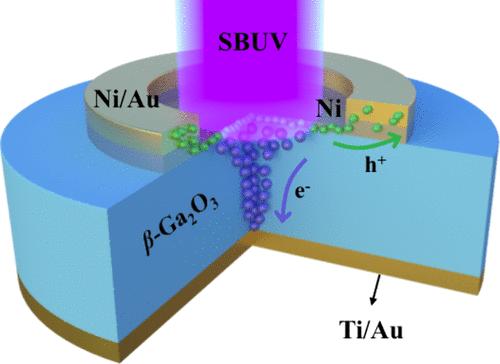基于Ni/β-Ga2O3垂直肖特基势垒二极管的高性能日盲紫外探测器
IF 9.1
1区 材料科学
Q1 CHEMISTRY, MULTIDISCIPLINARY
引用次数: 0
摘要
Ga2O3肖特基光电二极管由于其快速的光响应和易于制造,正被积极地用于太阳盲紫外(SBUV)探测。然而,受肖特基接触的限制,它们的表现大多低于预期。本文研究了一种具有超薄阳极电极的Ni/β-Ga2O3垂直肖特基势垒二极管(SBD)。通过简单的表面处理,提高了肖特基结的质量,从而提高了检测性能。暗电流达到了低于12fa的记录。由此获得了4.92 × 107的超高光暗电流比(PDCR)和2.76 × 1015 Jones的比探测率D*。响应时间也减少到毫秒级。实验结果表明,该装置在150℃高温下仍能正常工作。最重要的是,所制备的光电探测器具有良好的均匀性和工作稳定性。我们的研究结果为大规模生产高性能Ga2O3光电探测器提供了一种简单的方法,在紫外成像应用中具有巨大的潜力。本文章由计算机程序翻译,如有差异,请以英文原文为准。

High-Performance Solar-Blind Ultraviolet Photodetectors Based on a Ni/β-Ga2O3 Vertical Schottky Barrier Diode
Ga2O3 Schottky photodiodes are being actively explored for solar-blind ultraviolet (SBUV) detection, owing to the fast photoresponse and easy fabrication. However, their performance, limited by the Schottky contact, mostly underperforms the expectations. Herein, a Ni/β-Ga2O3 vertical Schottky barrier diode (SBD) with an ultrathin anode electrode is demonstrated. Through simple surface treatment, the quality of the Schottky junction is improved, thus the detection performance. The dark current reaches a record of less than 12 fA. Benefiting from this, an ultrahigh photo-to-dark current ratio (PDCR) of 4.92 × 107 and specific detectivity D* of 2.76 × 1015 Jones are achieved. The response time is also reduced to the order of milliseconds. The experimental result shows that the device still works properly at a high temperature of 150 °C. Most importantly, the fabricated photodetectors have good uniformity and operational stability. Our results provide a simple approach to mass produce high-performance Ga2O3 photodetectors, holding tremendous potential for UV imaging applications.
求助全文
通过发布文献求助,成功后即可免费获取论文全文。
去求助
来源期刊

Nano Letters
工程技术-材料科学:综合
CiteScore
16.80
自引率
2.80%
发文量
1182
审稿时长
1.4 months
期刊介绍:
Nano Letters serves as a dynamic platform for promptly disseminating original results in fundamental, applied, and emerging research across all facets of nanoscience and nanotechnology. A pivotal criterion for inclusion within Nano Letters is the convergence of at least two different areas or disciplines, ensuring a rich interdisciplinary scope. The journal is dedicated to fostering exploration in diverse areas, including:
- Experimental and theoretical findings on physical, chemical, and biological phenomena at the nanoscale
- Synthesis, characterization, and processing of organic, inorganic, polymer, and hybrid nanomaterials through physical, chemical, and biological methodologies
- Modeling and simulation of synthetic, assembly, and interaction processes
- Realization of integrated nanostructures and nano-engineered devices exhibiting advanced performance
- Applications of nanoscale materials in living and environmental systems
Nano Letters is committed to advancing and showcasing groundbreaking research that intersects various domains, fostering innovation and collaboration in the ever-evolving field of nanoscience and nanotechnology.
 求助内容:
求助内容: 应助结果提醒方式:
应助结果提醒方式:


